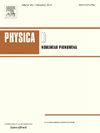Modeling the impacts of chemical substances and time delay to mitigate regional atmospheric pollutants and enhance rainfall
IF 2.9
3区 数学
Q1 MATHEMATICS, APPLIED
引用次数: 0
Abstract
Rainfall, a crucial process of the hydrological cycle, involves the condensation of atmospheric cloud droplets into raindrops that fall on the Earth’s surface, providing essentials for human well-being and ecosystem. Research studies show that the condensation–nucleation process for forming raindrops is reduced due to atmospheric pollutants. In this scenario, introducing chemical substances may effectively mitigate regional atmospheric pollution, and reduced atmospheric pollution may lead to adequate rainfall. In the present research work, we analyze rainfall dynamics using a modeling approach with the incorporation of a time lag involved between measuring the data for atmospheric pollution and introducing chemical substances in the regional atmosphere. Here, we assume the formation rate of cloud droplets as a decreasing function of atmospheric pollutants. It is also assumed that introducing chemical substances reduces regional atmospheric pollution. Involving time delay as a bifurcation parameter, we analyze the stability, direction, and period of the bifurcating periodic solutions arising through Hopf bifurcation. Along with this, the presented numerical simulations corroborate the analytical results of our mathematical model. The modeling study reveals that the use of chemical substances in proportion to the concentration of atmospheric pollutants measured at time () becomes crucial to mitigate the atmospheric pollutants because as time delay exceeds a threshold value, the system loses its stability and undergoes Hopf bifurcation.
模拟化学物质和时间延迟对减轻区域大气污染物和增强降雨的影响
降雨是水文循环的一个关键过程,它涉及大气中的云滴凝结成落在地球表面的雨滴,为人类福祉和生态系统提供必需品。研究表明,由于大气污染物的存在,雨滴形成的凝析成核过程被削弱。在这种情况下,引入化学物质可以有效减轻区域大气污染,减少大气污染可能导致充足的降雨。在目前的研究工作中,我们使用一种建模方法来分析降雨动力学,该方法结合了测量大气污染数据和在区域大气中引入化学物质之间的时间滞后。这里,我们假设云滴的形成速率是大气污染物的递减函数。还假定引入化学物质可以减少区域大气污染。将时滞作为分岔参数,分析了Hopf分岔引起的分岔周期解的稳定性、方向和周期。与此同时,所提出的数值模拟证实了数学模型的分析结果。建模研究表明,使用与时间(t−τ)测量的大气污染物浓度成比例的化学物质对于减轻大气污染物至关重要,因为当时间延迟超过阈值时,系统将失去稳定性并经历Hopf分岔。
本文章由计算机程序翻译,如有差异,请以英文原文为准。
求助全文
约1分钟内获得全文
求助全文
来源期刊

Physica D: Nonlinear Phenomena
物理-物理:数学物理
CiteScore
7.30
自引率
7.50%
发文量
213
审稿时长
65 days
期刊介绍:
Physica D (Nonlinear Phenomena) publishes research and review articles reporting on experimental and theoretical works, techniques and ideas that advance the understanding of nonlinear phenomena. Topics encompass wave motion in physical, chemical and biological systems; physical or biological phenomena governed by nonlinear field equations, including hydrodynamics and turbulence; pattern formation and cooperative phenomena; instability, bifurcations, chaos, and space-time disorder; integrable/Hamiltonian systems; asymptotic analysis and, more generally, mathematical methods for nonlinear systems.
 求助内容:
求助内容: 应助结果提醒方式:
应助结果提醒方式:


